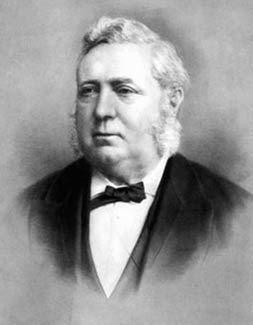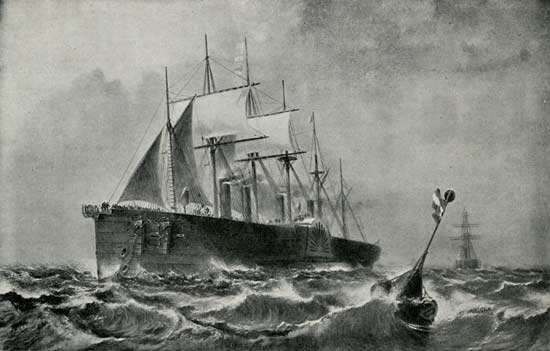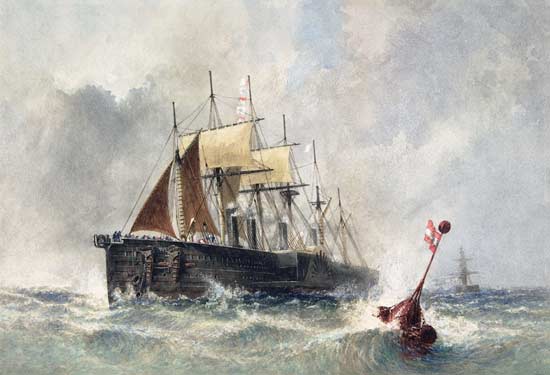Introduction: This remembrance of Sir James Anderson, who after captaining the Great Eastern on the Atlantic expedition of 1865 became a major figure in the management of a number of the leading cable companies in Britain, was published in The Electrical Engineer, New York, 14 June 1893.
The author, Arthur E. Kennelly, was employed at Thomas Edison’s West Orange laboratory at the time, and subsequently had a long and illustrious career in electrical engineering. In 1902 Kennelly was in engineering charge of the Vera Cruz-Frontera-Campeche cable for the Mexican Government.
|
Reminiscences of Sir James Anderson
by A.E. Kennelly
The announcement of the death of Sir James Anderson in London, on the 7th ult., must have been everywhere met with unfeigned regret. Sir James Anderson was born in 1824 at Dumfries in Scotland. He showed early a strong inclination for an active life, and went to sea as apprentice in the merchant service in 1840. In 1851 he entered the Cunard Company’s service, and commanded their ships for several years. After the failure of the first Atlantic cable in 1858, and when a new company was formed in 1864 for the purpose of laying another cable with the aid of the S.S. “Great Eastern” the chairman applied to the Cunard company for the services of a commander in whose skill and ability they could place absolute confidence. In compliance with that request, Captain Anderson commanded the “Great Eastern” during the 1865 expedition.

Sir James Anderson |
After the cable unfortunately parted in deep water during paying out, and after several unsuccessful attempts had been made to recover it, the “Great Eastern “ returned to England, with the hopes of the enterprise almost abandoned, and with its capital generally supposed to be lost in the sea. It was in a great measure due to the firmness of Captain Anderson, and his earnest conviction of ultimate success, that the directors regained courage, and raised among themselves the money for a new cable. It is well known how in 1866, Captain Anderson again took the “Great Eastern” over the Atlantic, this time successfully laying the metal thread between the old and new worlds, and how, this done, the 1865 cable was also safely recovered the same Autumn in mid-ocean, a task then almost undreamt of. It was re-spliced, and also landed finally on the American shore. For his services on this eventful occasion Captain Anderson received the honor of knighthood.
Resigning his post in the Cunard service, Sir James Anderson devoted himself entirely to submarine telegraphy, with whose development his name has become so thoroughly identified. Director in nearly all the submarine cable companies existing, he was the managing director of the Eastern Telegraph Company, whose cables spread from England to India and ramify throughout the Mediterranean Sea. He was also Managing Director of the associated African cable companies whose lines engird the dark continent. To these enterprises he gave his entire attention with an earnestness and devotion that were characteristic of the man. Messages from any of the hundred telegraph cable stations in that wide-spread electric union came to him at all hours of the day and were brought to his house by messengers at night.
Many a man, far down the African coast, felt his tasks lighten, and his difficulties less beset, under the consciousness of that everwatchfulness of the chief who was always within an hour’s hail. Even when Sir James Anderson revisited Dumfries, as he usually did each year, this attention was scarcely less vigilant, and the orders for station, and directing the movements of a small fleet of cable steamers, would issue from Dumfries almost as uninterruptedly as from the London office,
The devotion to duty and earnestness of purpose which are the qualities so revered by sailors, were preeminently characteristic of Sir James Anderson. That firmness and energy he infused into all who came in contact with him.
Courteous and forbearing, of fine presence and dignified mien, he impressed with respect all whom he met. The accompanying engraving is from an excellent photograph taken not long since.
He added to great administrative ability, that keen insight and grasp of facts and events that so often distinguishes the trained legal mind. Everything that he wrote, said, or did, carried the impression of careful accuracy. The book and papers that he has written on submarine telegraphy are justly authoritative, on that account especially.
Of strong frame, and with a constitution that had never given way to a day’s illness, he felt very keenly the loss of his wife, Lady Anderson, in September, 1891. From that blow be never recovered, and his health began to fail visibly in the year following, although no apprehensions were at that time entertained for his life.
To all who have ever met him, his memory will usher in regret. By his colleagues, in particular, his loss will be most keenly felt. But to all who served under him, scattered over sea and land, the tidings of his death will bring heartfelt sorrow. Their welfare had been so long his care, their work his pride, their united success his ambition. As one of those who served under him for several years, one whose fortune it was to see him frequently and know him well, the writer desires to add his personal tribute of sorrow and esteem.
We are indebted to Mr. George G. Ward, vice-president of the Commercial Cable Company, for the accompanying picture of the “Great Eastern” which, we think, will fitly accompany Mr. Kennelly’s interesting notes. The inscription under the picture was placed under an original for Mr. Ward by Sir James, who was his personal friend. Mr. Kennelly has told how Sir James Anderson’s efforts and perseverance resulted in success a little later than the discouraging episode illustrated in the engraving.

|
“The Great Eastern, having grappled the lost cable of 1865 three times, getting it from the bottom ¾ of a mile, ¼ and ½ a mile, in the several attempts, finds her tackling exhausted, steers homeward, a gale springing up, and night coming on—August 12th, 1865.”—James Anderson.
The “Great Eastern” Under Command Of Capt. Anderson, Cable Grappling, 1865. |
The illustration above is from a reproduction of a painting by Robert Dudley, who accompanied the 1865 expedition as official artist for William Russell’s book on the voyage. The reproduction was published by the British trade paper The Electrician; this advertisement is from the 1895 edition of the company's Electrical Trades Directory:
The original painting was in the collection of Sir James Anderson and is shown below. In a letter to The Electrical Engineer , published on 16 August 1893, Dudley provided further information about the details of the image:
THE STORY OF A CABLE BUOY.
In your number for June 14 last appeared an illustration accompanying Mr. A. E. Kennelly’s “Reminiscences of Sir James Anderson.” Perhaps your courtesy will permit me, as the artist who accompanied the Atlantic Telegraph Expeditions of 1865 and 1866, to say that the illustration you give is reproduced from a photograph of a picture painted by me in 1865 for Sir James Anderson, who, not long before his decease, showed me one of the excellent photographs taken from it. The photograph, however, cannot correctly be called “an original” as, of course, only the picture can be so termed. It was in the Royal Naval Exhibition of 1891. I am induced to write a few lines to supplement the short description given beneath your illustration.
The story told by the picture has a great point of interest in the buoy in the foreground (or forewater)—the disadvantage pictorially of this object having, from its prominence, a tendency to dwarf the ship, is counterbalanced by the interest of the story of the buoy. It had been lowered from the bulwarks of the great ship, and was anchored, so far as almost exhausted means of tackling would permit, at a depth of some 2¼ miles, to mark the spot where the electric cable had gone down, and were lay buried—then—so many and such sanguine hopes.
A sketch of mine of this buoy appeared in the Illustrated London News of September 2, 1865. The buoy itself, driven by the storms of the succeeding winter into far distant seas, was—as I saw subsequently mentioned in some paper—discovered by the captain of a ship at sea and identified by that sketch.
The ship in the offing is H.M.S. “Terrible” the consort of the “Great Eastern” in the memorable expeditions of 1865 and 1866. The scene, in fact, pictures the parting of the ships over the grave of the lost cable.
No doubt all these particulars bear especial interest for those in whom the memory of the events is still living and keen; but any record of such enterprise must possess some interest for all—even after many years.
Robert Dudley, 31 Lansdowne Road, Notting Hill, London.
July 18, 1893.

Robert Dudley’s painting from which the illustration above was taken |

Dudley's sketch of the buoy as published in the Illustrated London News
|
Dudley evidently also made another painting for Sir James Anderson. This hand-lettered presentation certificate is in the archives of the Porthcurno Telegraph Museum [PIC///152/] and describes a painting of the scene on the night of September 1st 1866 when the lost cable of 1865 was recovered. The location of the painting itself is not presently known.

Detail of illustrations |
At top left:
Horses head with Trident
Shield showing a three-masted ship and a banner with the motto ‘Stand Sure’
To Sir James Anderson Knight who commanded the SS Great Eastern during the Atlantic Telegraph Expeditions of 1865 and 1866 This Picture of the Recovery of the lost Cable of 1865 on the night of September the first 1866 Painted by Robert Dudley is Presented in testimony of high regard and esteem by the undernamed few amongst his many Friends |
Cyrus W. Field
Thomas Brassey
Levi P. Morton
Peter Coats
Thomas Coats
Sherard Osborn |
J.S. Morgan
C. Borthwick
Latimer Clark
Henry Bewley
Archibald Baxter
Philip Ramson |
George Elliot
J.R. McClean
Cromwell P. Varley
Edward Cropper
T. Brassey Junr.
W. Shuter |
|

